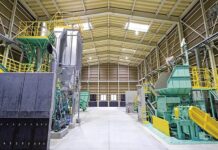Warehouses today face immense pressures – more SKUs, faster order turnarounds, omnichannel fulfillment, seasonal peaks, and ever more customer demands. Yet expansion via new buildings or sites carries major costs and operational disruption. This forces DCs to maximize utilization of existing infrastructure.
Installing storage mezzanine structures allows boosting capacity upwards, gaining up to 100% more space by better utilizing unused vertical real estate. Engineered mezzanine storage optimizes footprints via customizable storage layers, minus the hassles of construction projects.
Overview of Mezzanine Platform Benefits
Mezzanines inserted into warehouses deliver numerous advantages:
Double+ Cubic Storage Capacity
Structural and roll-formed mezzanines essentially create an entire second floor without facility expansion costs. Some units can support stunning per-square-foot densities up to 1000 pounds. This allows storing heavier materials or even equipment.
Streamlined Organization and Access
Mezzanines partition warehouse space for specialized functions – high-velocity order fulfillment zones, reserve inventory areas, kitting operations etc. Strategic layouts also improve inventory visibility and access.
Material Handling System Integration
Many mezzanines allow incorporating conveyors or converting to automated storage and retrieval systems. This significantly ups throughput capacity and order accuracy via superior inventory control.
Faster ROI Than New Buildings
Prefab modular construction enables rapid mezzanine installation – as fast as 6-8 weeks. This allows bringing extra capacity online quicker at a fraction of the cost of adding new DC buildings.
Key Mezzanine Structure Design Variants
Warehouses can choose from 3 main mezzanine structure alternatives to match functional layout and budget needs:
Roll Formed Mezzanines
Roll formed mezzanines are constructed from solid steel panels custom folded into modules on site using a roll former. Their prefab nature allows rapid assembly into a second tier within existing buildings. Custom sizing also prevents wasted space.
Benefits
- Faster installation than structural types
- Adaptable layouts and accessories like bins, partitions
- Cost-efficient mezzanine option
Typical Applications:
- Pick modules in fulfillment zones
- Work platforms for light manufacturing
Structural Mezzanines
Structural mezzanines are entirely independent platforms framed with heavy duty structural steel. This makes them ideal for intensive material loads. Their self-contained design means installation causes minimal facility disruption.
Benefits:
- Handles very heavy loads – up to 1000 lbs. per square foot
- Supports multiple mezzanine tiers
- Does not load-bear on facility, fully customizable
Typical Applications:
- Heavy equipment storage and maintenance access
- Multi-level pick modules
Rack-Supported Mezzanines
Rack-supported mezzanines fasten a steel floor deck onto the top beams of existing warehouse racking. It is the most affordable mezzanine option.
Benefits:
- Utilizes current racking – very cost-effective
- Easy to disassemble and relocate as needs change
Typical Applications:
- Upper level pick modules
- Small parts storage mezzanines
How Storage Mezzanines Boost Warehouse Productivity
Beyond just expanding square footage, mezzanines drive gains across warehouse metrics:
Doubled Throughput Capacity
Added storage tiers let warehouses handle more orders simultaneously. Specialized function zones also reduce operation friction. Conveyors and picking assists integrated with mezzanines additionally up fulfillment velocities.
Reduced Labor Requirements
Better planned layouts minimize pick and replenishment travel distances. Automating inventory flows via integrated picking systems or AS/RS further cut labor needs. This allows reallocating staff to more value-added roles.
Improved Inventory Accuracy
Zone storage segments stock by velocity, type, and function. This enables optimized WMS rules per SKU for more organized control. Automation also slashes misplaced inventory via system-directed putaway and retrieval.
Maximized Equipment Utilization
Slide-out platform extensions, integrated cranes, and stairs give better access to store and service heavy machinery on mezzanines. Enabling dual-use of vertical space cuts equipment idle time.
Enhanced Safety and Compliance
Professional mezzanine installers adhere to strict quality and safety guidelines. Handrails, toe guards, end closures, and marked transition areas make mezzanines secure. Building permits and inspections also verify structural soundness.
Increased Flexibility For Growth Surges
Many mezzanine structures allow rapid disassembly or expansion upwards via additional tiers. This provides temporary capacity bursts for Black Friday surges, new product launches or sudden business upticks.
Key Planning Considerations for Mezzanine Deployment
To maximize productivity gains, mezzanine integration must consider existing warehouse layouts, processes and material flows.
Site Evaluation
Dimensional and infrastructure surveys assess where mezzanines best fit. Evaluators classify ceiling heights, weight limits, bay spacing, obstruction zones, sprinklers, and ramp positions ideal for second tiers.
Building Permits
Local codes often mandate permits and professional engineering inspection before facility alterations. Mezzanine sellers assist in navigating often complex regulatory approval processes.
Weight/Load Analysis
Determining mezzanine deck strength needs relates to the heaviest materials loaded during use. Equipment like lift-assist carts also factor in the total weight. This calculates regional maximum loads per square foot.
Access Structure Requirements
Stairways for mezzanine access must meet safety codes. Railings, corner guards and toe plates boost safety. Non-combustible construction materials allow easy sprinkler integration for fire suppression.
Layout Optimization Software
Computer modeling helps orient mezzanines to optimize ergonomics and workflow efficiency. The software also ensures inventory capacity aligns with current and planned SKU expansion.
Why Factory-Certified Mezzanine Installation Matters
Attempting do-it-yourself mezzanine assembly risks code violations, structural defects and even collapse. Utilizing factory-authorized mezzanine sellers ensures:
Engineered Quality
Expert mezzanine resellers guarantee platforms are designed to industrial engineering standards for robust performance.
Code Compliance
Trained technicians ensure all guard rails, fireproofing, electrical routing and accessibility features adhere to stringent municipal codes.
Safety Best Practices
Veteran installation crews understand all essential safety protocols during platform integration. This prevents workplace accidents.
Manufacturer Warranties
Reseller partnerships mean manufacturers warranty solid construction and component performance for years after installing a storage mezzanine system.
While mezzanines require serious upfront investment, the long-term space efficiency and operational gains justify costs handsomely. Utilizing certified mezzanine resellers streamlines safe integration with your warehouse ecosystem.
Conclusion
Installing a properly planned and integrated storage mezzanine structure offers transformative benefits for warehouses bursting at the seams. Adding a customized secondary tiered platform minimizes the extreme disruptions and expenses of facility expansions. Mezzanines also create organized compartmentalized space to significantly amplify storage density, inventory control and order processing capacities. By doubling cubic capacities and spatial utilization along the vertical axis, mezzanines boost ROI on existing infrastructure spending. Whether seeking to elevate order fulfillment rates, maximize reserves handling, or safely stow heavy equipment, warehouse managers find perfect solutions with expertly engineered mezzanine storage systems.





























